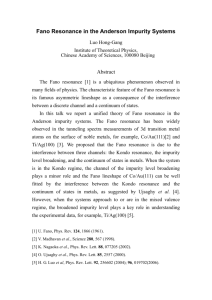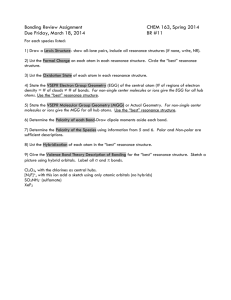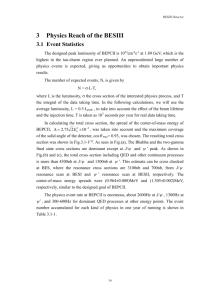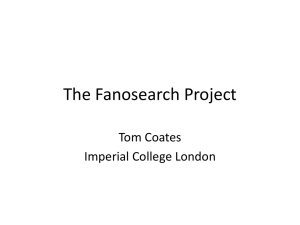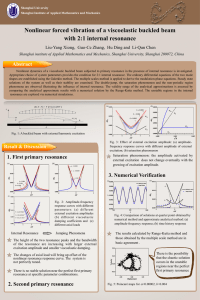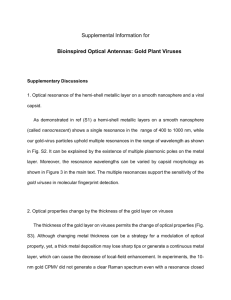Supplementary Information (doc 6970K)
advertisement
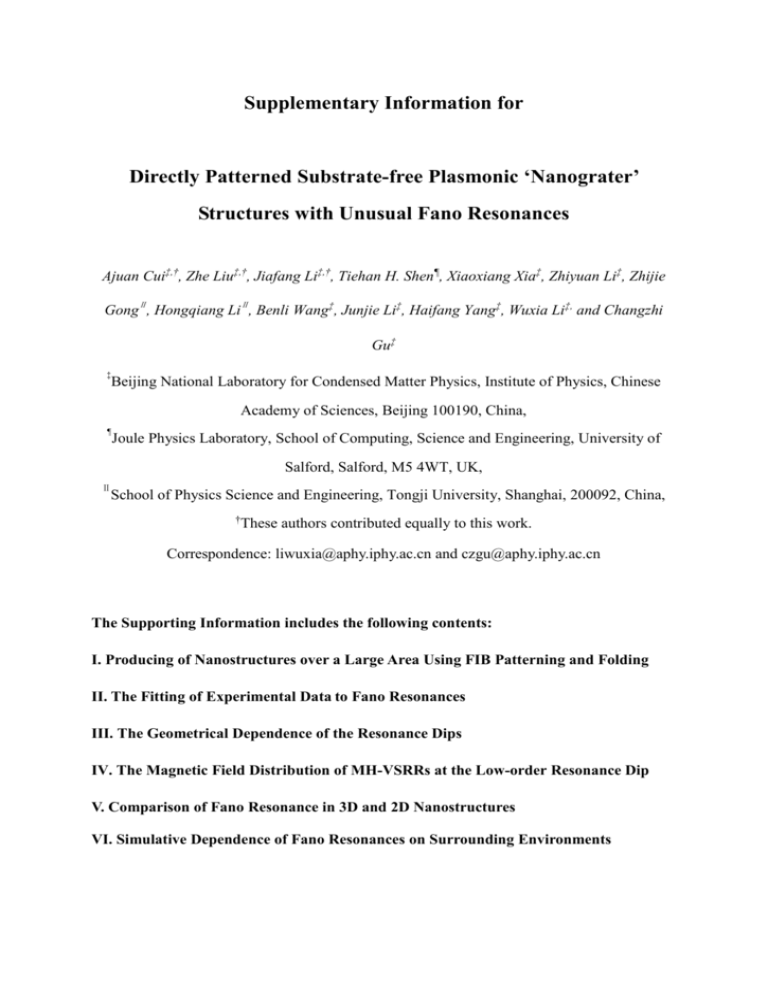
Supplementary Information for Directly Patterned Substrate-free Plasmonic ‘Nanograter’ Structures with Unusual Fano Resonances Ajuan Cui‡,†, Zhe Liu‡,†, Jiafang Li‡,†, Tiehan H. Shen¶, Xiaoxiang Xia‡, Zhiyuan Li‡, Zhijie GongⅡ, Hongqiang LiⅡ, Benli Wang‡, Junjie Li‡, Haifang Yang‡, Wuxia Li‡, and Changzhi Gu‡ ‡ Beijing National Laboratory for Condensed Matter Physics, Institute of Physics, Chinese Academy of Sciences, Beijing 100190, China, ¶ Joule Physics Laboratory, School of Computing, Science and Engineering, University of Salford, Salford, M5 4WT, UK, Ⅱ School of Physics Science and Engineering, Tongji University, Shanghai, 200092, China, † These authors contributed equally to this work. Correspondence: liwuxia@aphy.iphy.ac.cn and czgu@aphy.iphy.ac.cn The Supporting Information includes the following contents: I. Producing of Nanostructures over a Large Area Using FIB Patterning and Folding II. The Fitting of Experimental Data to Fano Resonances III. The Geometrical Dependence of the Resonance Dips IV. The Magnetic Field Distribution of MH-VSRRs at the Low-order Resonance Dip V. Comparison of Fano Resonance in 3D and 2D Nanostructures VI. Simulative Dependence of Fano Resonances on Surrounding Environments I. Producing of Nanostructures over a Large Area Using FIB Patterning and Folding Figure S1. a, A schematic diagram depicting the process of FIB milling and in situ FIB folding. b, An SEM image showing details of the actual structure fabricated. c, An optical micrograph of the sample over a wider area (about 0.5 mm ×0.5 mm). The feasibility of scaling-up sample size by FIB patterning and folding has been explored in the production of a simple nanograter structure (Fig. S1) using a ‘step-repeat’ strategy. Figure S1 |a depicts the process of a unit structure that is fabricated using FIB-milling to cut off the three sides of a rectangle pattern followed by FIB-irradiation induced folding of the structure at the side that remaining connected to the host film. For a rectangle pattern size of 2.0 m ×1.0 m (which includes a scan length of 5.0 m for FIB milling and 1.0 m for FIB folding) in a ‘primitive unit cell’ of 6.0 m × 4.0 m, 16 minutes are required to complete the fabrication in an ion beam processing area, the ‘field of view’ (FOV) of 96.0 µm× 96.0 µm using an ion beam current of 33 pA. Larger sample area is achieved straightforward by simply stepping the sample stage and repeating the process (the step-repeat process). For such structures to be produced in a 6 × 6 FOV matrix, a total time of 9.6 hours is required. An SEM image showing the details of such a sample can be found in Fig. S1|b, whilst Fig. S1|c is an optical micrograph showing a larger area view of the sample. The underlying Cu grid lines resulted in the defects observable in Fig.S1|c, which may be avoided by using a more sparsely spaced Cu grid or other type of ‘picture frame’ at the edges of the Au film. When a larger ion beam current, for instance, 100 pA, is used, an array of such patterns can be fabricated in an area of 1.0 mm ×1.0 mm within 10 hours. For an FIB/SEM system installed with appropriate hardware and software for controlling the stage movements, the scaling-up of effective sample area is clearly achievable in practice. II. The Fitting of Experimental Data to Fano Resonances Figure S2. a and b, Experimental data and fitted lines (based on Equation 2) of the transmission spectra of MH-VSRRs in (a) high-order and (b) low-order wavelength ranges. The Fano asymmetry factors of the two resonances are -0.14 and 0.86, respectively. The experimental data around the low-order and high-order resonance regions of the measured transmission spectra of the MH-VSRRs shown in Fig. 3e were fitted using a Fano resonance formula that is based on the classical description1, 2: ( r q / 2)2 TMH VSRRs ( ) C0 TMHs ( ) [1 C1 ] ( r )2 ( / 2)2 (1) Here TMHs ( ) is the transmission spectrum of the corresponding rectangular hole arrays in the absence of VSRRs, C0 and C1 are the non-resonant transmission coefficients, r is the resonance wavelength, is the linewidth, and q is the Fano asymmetry factor. The case of q =0 means the lineshape is symmetric. In this specific fitting procedure, since both TMH VSRRs ( ) and TMHs ( ) are measured data, it is the ratio of TMH VSRRs ( ) and TMHs ( ) that is actually fitted to the equation below: TMH VSRRs ( )/TMHs ( ) C0 [1 C1 ( r q / 2)2 ] ( r )2 ( / 2)2 (2). As shown in Fig. S2, the experimental data are well fitted with Fano asymmetry factors of -0.14 and 0.86, for the high-order and low-order resonance, respectively. III. The Geometrical Dependence of the Resonance Dips Figure S3. a, A schematic diagram of the MH-VSRR structure with the relevant geometrical parameters labeled. b, Calculated transmission spectra of MH-VSRRs with VSRRs of different width (l) under y-polarized excitation condition. c, The wavelength of the low-order resonance dip as a function of l. It can be seen that the low-order dip is linearly shifted while high-order dip is almost unchanged. Our FDTD simulation results suggest that the wavelength of the high-order resonance is a “local” resonance and is dependent on the effective length (h) of the arms of the VSRRs (Fig. S3 and Fig. S4)3. For the low-order Fano resonance, the decrease in l (Fig. S3), the increase in h (Fig. S4), or the increase in ay (Fig. S5), consistently induces a linear ‘red-shift’. 3D MH-VSRR nanograters with different geometrical parameters (listed in Table S6) were fabricated. The experimental measurements of the samples show that the wavelength of the low-order resonance dip obeys a nearly linear relationship with the empirical length (EL), which is defined as EL=h+(ax-l)/2+ay/2, as plotted in Fig. 4c. Figure S4. a, The calculated transmission spectra of MH-VSRRs with SRRs of different heights (h) under y-polarized excitation. b and c, The wavelength of low-order and high-order resonance dip as a function of h. Both resonance dips are linearly shifted with increasing h. Figure S5. a, The calculated transmission spectra of MH-VSRRs with different values of ay under y-polarized excitation. b, The wavelength of low-order resonance dip as a function of ay. The change in low-order resonance dip wavelength is approximately linear with the increase of ay. However, no obvious trend was observed in the change of the high-order resonance dip, which is influenced by the blue shift of the transmission peak of the rectangular void arrays. Table S6. The FIB fabricated 3D MH-VSRR nanograters with various geometrical parameters and the corresponding wavelengths of the low-order resonance dips. The latter results are presented in Fig. 4c. The value of EL is defined as EL=h+(ax-l)/2+ay/2. IV. The Magnetic Field Distribution of MH-VSRRs at the Low-order Resonance Dip Figure S7. a, The simulated current distributions of the sample at the low-order resonance dip as in Fig. 4d. The symbols of triangle, diamond, square and circle represent the turning points of A, B, C and D, along the current flow route. b, The calculated |H|, Hz and Hy in x-z, x-y and x-z plane, respectively. The 3D current flow in a can be analyzed with two L-shaped current flows along route A-B-C and route B-C-D, respectively. While the current flow along route A-B-C induces Hz in the x- plane, Hy in the x-z plane can be induced by the current flow along route B-C-D. As shown in Fig. S7, the 3D current flow in MH-VSRRs is the hybridization of two L-shaped current flows4 along route A-B-C and route B-C-D, respectively. While the current flow along route A-B-C induces Hz in the x-y plane, Hy in the x-z plane can be induced by the current flow along route B-C-D. These are clearly represented in the magnetic field distribution in Fig. S7b. However, the current flow along route B-C-D cannot be excited by y-polarized light under normal incidence. In such a case, the actual current flow along route B-C-D must result from the hybridization with the current flow along route A-B-C that can be induced by the y-polarized light3-6. Therefore, it is the crucial 3D hybridization in current flow that makes possible the Fano resonance excited under the unconventional y-polarized excitation scheme. This can be understood in other words: the low-order Fano resonance is from an interaction of the resonance modes from the metallic holes and the L-shaped structure (indicated by the route A-B-C-D in Fig. S7a). In comparison, the high-order Fano resonance is from an interaction of the resonance modes from the metallic holes and the vertical arms of the VSRRs (indicated by the route C-D in Fig. S7a). V. Comparison of Fano Resonance in 3D and 2D Nanostructures Figure S8. a, SEM images of fabricated U-shape SRRs having different inclination angles (θ) with aspect to the horizontal rectangular hole arrays. The 3D MH-VSRR structures with θ=90o will change into 2D planar plasmonic structures when θ decreases to 0o. b and c, Experimental and calculated transmission spectra of U-shape SRRs with different values of θ under y-polarized excitation. As shown in Fig. S8, when the inclination angle θ reduces from 90o to 60o and 30o, the steep profile of the asymmetric Fano lineshape is quickly degraded. This feature clearly indicates that 3D hybridization coupling effect is a unique property of the true 3D MH-VSRRs and the unique Fano resonance effect is significantly degraded in the usual 2D planar plasmonic nanostructure. This advantage of 3D geometry over 2D geometry may be very useful in designing strongly coupled MM nanostructures to achieve high-sensitivity optical sensors. VI. Simulative Dependence of Fano Resonances on Surrounding Environments Figure S9| The simulated results of low-order and high-order Fano resonance dips as a function of the refractive index of the surrounding medium. References: 1. 2. 3. 4. 5. 6. Luk'yanchuk, B.; Zheludev, N. I.; Maier, S. A.; Halas, N. J.; Nordlander, P.; Giessen, H.; Chong, C. T. Nat Mater 2010, 9, 707-715. Cheng, F.; Liu H. F.; Li, B. H.; Han, J.; Xiao H.; Han X. F.; Gu C. Z.; Qiu X. G. Appl. Phys. Lett. 2012, 100, 131110. Chen, W. T.; Chen, C. J.; Wu, P. C.; Sun, S. L.; Zhou, L.; Guo, G. Y.; Hsiao, C. T.; Yang, K. Y.; Zheludev, N. I.; Tsai, D. P. Opt. Express 2011, 19, 12837-12842. Husu, H.; Makitalo, J.; Laukkanen, J.; Kuittinen, M.; Kauranen, M. Opt. Express 2010, 18, 16601-16606. Katsarakis, N.; Koschny, T.; Kafesaki, M.; Economou, E.N.; Soukoulis, C.M. Appl. Phys. Lett. 2004, 84, 2943-2945. Tatartschuk, E.; Shamonina, E.; Solymar, L. Opt. Express 2009, 17, 8447-8460.
